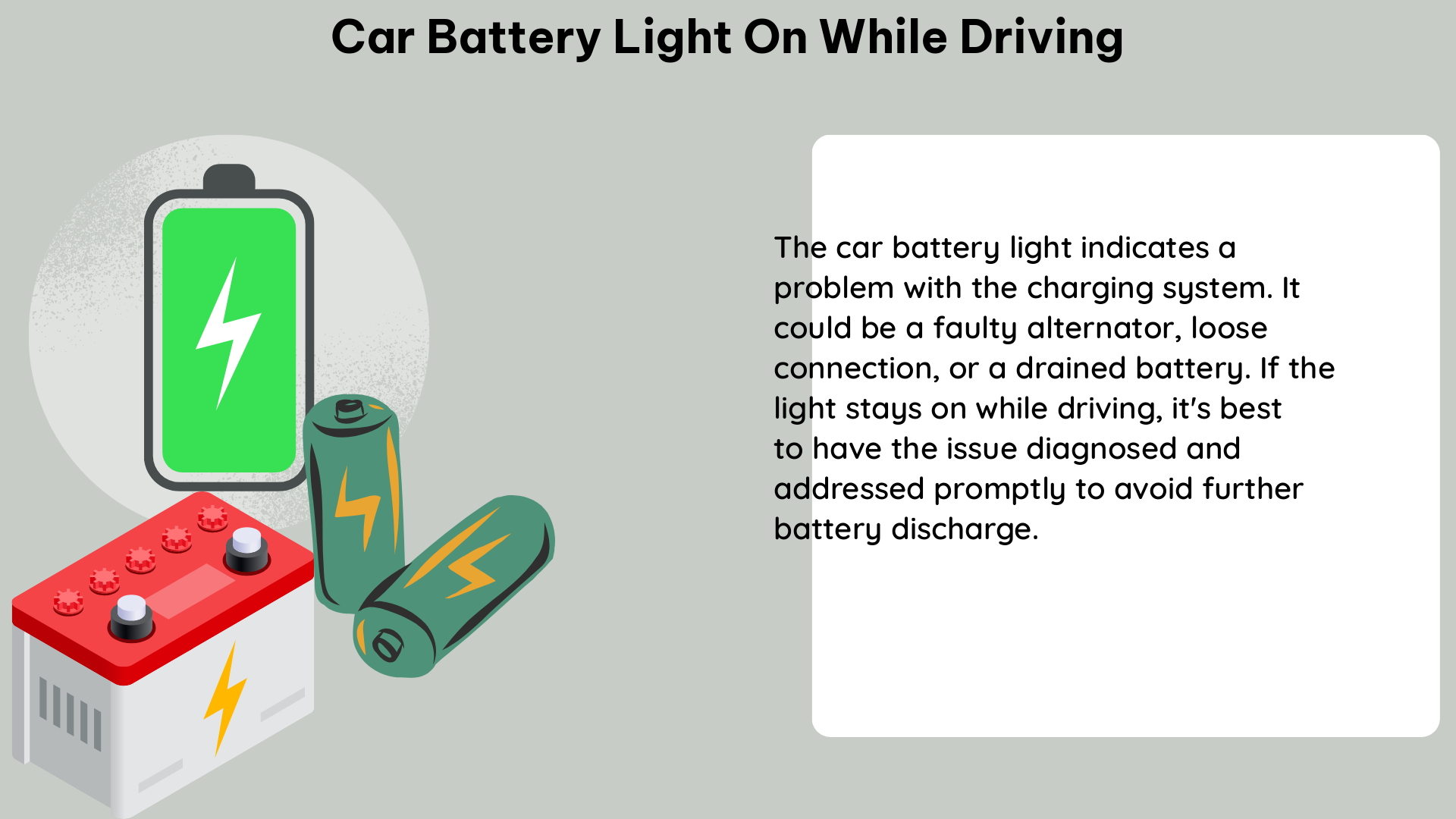The car battery light illuminating while driving is a clear indication that there is an issue with the vehicle’s electrical system, specifically the battery and charging components. This problem can be triggered by a variety of factors, including a faulty battery, charging system malfunctions, wiring problems, and more. Understanding the underlying causes and taking prompt action is crucial to prevent further damage and ensure your safety on the road.
Faulty Battery
One of the most common reasons for the battery light to turn on while driving is a faulty or aging battery. Typically, car batteries have a lifespan of 3 to 5 years, and as they age, their ability to hold a charge diminishes. Additionally, battery corrosion or physical damage can also trigger the battery light.
- Battery Age: The average car battery lasts between 3 to 5 years, with some high-quality batteries lasting up to 7 years. As the battery ages, its capacity to hold a charge decreases, leading to the battery light illuminating.
- Battery Corrosion: Corrosion on the battery terminals or connections can disrupt the flow of electricity, causing the battery light to come on. This corrosion is often caused by a chemical reaction between the battery acid and the metal terminals.
- Battery Damage: Physical damage to the battery, such as cracks, leaks, or a damaged casing, can also trigger the battery light. This type of damage can compromise the battery’s ability to function properly.
Charging System Issues

The alternator is responsible for charging the battery while the vehicle is running. If the alternator is not functioning correctly, the battery will not receive the necessary charge, causing the battery light to illuminate.
- Alternator Failure: A malfunctioning alternator can prevent the battery from being properly charged, leading to the battery light turning on. Alternator failure can be caused by worn brushes, a faulty voltage regulator, or a damaged alternator belt.
- Alternator Belt Problems: The serpentine belt, which drives the alternator, can become worn, loose, or even break, affecting the alternator’s ability to charge the battery and triggering the battery light.
- Voltage Regulator Malfunction: The voltage regulator controls the voltage that the alternator delivers to the battery. If the voltage regulator is not functioning correctly, it can cause the battery to be undercharged or overcharged, leading to the battery light coming on.
Wiring and Electrical Issues
Wiring problems and electrical system malfunctions can also contribute to the battery light turning on while driving.
- Wiring Damage: Damaged, loose, or corroded wiring in the electrical system can disrupt the flow of electricity, causing the battery light to illuminate. This can be due to a variety of factors, such as rodent damage, age-related wear, or improper installation.
- Electrical System Glitches: Modern vehicles have complex electrical systems that rely on software and electronic components to function correctly. If there is a software glitch or a problem with an electronic component, it can trigger the battery light.
Parasitic Drain
Parasitic drain, which occurs when something in the car continues to draw power from the battery even when the vehicle is turned off, can also cause the battery light to come on while driving.
- Faulty Relays: Malfunctioning relays, which are responsible for controlling various electrical components, can cause a parasitic drain on the battery, leading to the battery light illuminating.
- Electrical Component Issues: Problems with electrical components, such as the radio, lights, or other accessories, can also result in a parasitic drain, triggering the battery light.
Addressing the Issue
If the battery light comes on while driving, it’s crucial to address the problem promptly to prevent further damage and potential breakdowns. Here are some steps you can take:
- Perform a Visual Inspection: Carefully inspect the battery, alternator, and wiring for any signs of damage, corrosion, or loose connections.
- Use a Multimeter: Measure the battery voltage and the alternator’s output voltage to determine if the charging system is functioning correctly.
- Check for Parasitic Drain: Use a multimeter to measure the current draw on the battery when the vehicle is turned off to identify any parasitic drain issues.
- Consult the Owner’s Manual: Refer to your vehicle’s owner’s manual for specific troubleshooting steps and recommended maintenance intervals for the battery and charging system.
- Seek Professional Assistance: If you’re unsure of the root cause or don’t feel comfortable performing the necessary repairs, it’s best to consult a qualified automotive technician.
Addressing the car battery light issue promptly is crucial to prevent further damage and ensure your safety on the road. By understanding the common causes and taking the appropriate steps, you can quickly identify and resolve the problem, keeping your vehicle’s electrical system in top condition.
References:
– 7 Reasons Why Battery Light is On
– Why is My Battery Light On?
– How Long Can You Drive with the Battery Light On?

The lambdageeks.com Core SME Team is a group of experienced subject matter experts from diverse scientific and technical fields including Physics, Chemistry, Technology,Electronics & Electrical Engineering, Automotive, Mechanical Engineering. Our team collaborates to create high-quality, well-researched articles on a wide range of science and technology topics for the lambdageeks.com website.
All Our Senior SME are having more than 7 Years of experience in the respective fields . They are either Working Industry Professionals or assocaited With different Universities. Refer Our Authors Page to get to know About our Core SMEs.